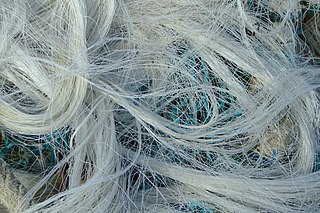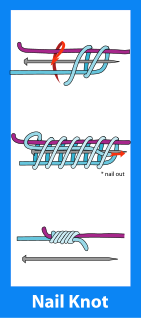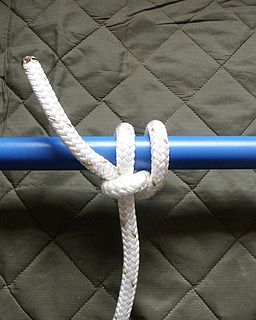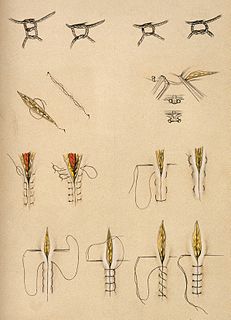
A knot is an intentional complication in cordage which may be useful or decorative. Practical knots may be classified as hitches, bends, or splices: a hitch fastens a rope to another object; a bend unites two rope ends; and a splice is a multi-strand bend or loop. A knot may also refer, in the strictest sense, to a stopper or knob at the end of a rope to keep that end from slipping through a grommet or eye. Knots have excited interest since ancient times for their practical uses, as well as their topological intricacy, studied in the area of mathematics known as knot theory.

A fishing line is a cord used or made for angling. Fishing line is generally as durable as and comparable to a string. Important parameters of a fishing line are its length, material, and weight. Factors that may determine what line an angler chooses for a given fishing environment include breaking strength, knot strength, UV resistance, castability, limpness, stretch, abrasion resistance, and visibility. Most modern lines are made from nylon, braided polymers, or silk.
A whipping knot or whipping is a binding of marline twine or whipcord around the end of a rope to prevent its natural tendency to fray. The whipping can be made neat and permanent by tying it off or sewing the ends of the twine through the rope. According to The Ashley Book of Knots, "The purpose of a whipping is to prevent the end of a rope from fraying ... A whipping should be, in width, about equal to the diameter of the rope on which it is put ... [Two sailmaker's whippings], a short distance apart, are put in the ends of every reef point, where the constant "whipping" against the sail makes the wear excessive; this is said to be the source of the name whipping." The other type of stopping knot is a seizing knot.

Fly fishing is an angling method that uses a light-weight lure—called an artificial fly—to catch fish. The fly is cast using a fly rod, reel, and specialized weighted line. The light weight requires casting techniques significantly different from other forms of casting. The flies may resemble natural invertebrates, baitfish, or other food organisms.

A blood knot is a bend knot most usefully employed for joining sections of monofilament nylon line while maintaining a high portion of the line's inherent strength. Other knots used for this purpose can cause a substantial loss of strength. In fly fishing, this serves to build a leader of gradually decreasing diameter with the castable fly line attached at the large diameter end and the fly or hook at the small diameter end. The principal drawback to the blood knot is the dexterity required to tie it. It is also likely to jam, which is not a concern in fishing line, which is no great loss to cut, but may be a concern in normal rope. "Blood knot" may refer to "a double overhand knot tied in a cat-o'-nine-tails."
The barrel knot, called blood knot by Keith Rollo, is the best bend there is for small, stiff or slippery line. The ends may be trimmed short and the knot offers the least resistance possible when drawn through water.

The sheet bend is a bend. It is practical for joining lines of different diameter or rigidity.

Monofilament fishing line is fishing line made from a single fiber of plastic, as opposed to braided fishing line constructed from multiple fibers of material. Most fishing lines are now monofilament because monofilament fibers are cheap to produce and are produced in a range of diameters which have different tensile strengths. Monofilament line is also manufactured in different colors, such as clear, white, green, blue, red, and fluorescent.

The Bimini twist is a fishing knot used for offshore trolling and sportsfishing and the creation of double-line leaders. A Bimini twist creates a loop at the end of the line in which it is tied. The loop secured at the top with a long barrel of coiled line created by the tying process. A Bimini twist loop is stronger than the line itself. It is one of the rare knots that does not weaken the line in which it is tied. It is a simple method of doubling your fishing line in order to prevent chafing or to create the necessary loop in order to attach a wind-on leader without using strength in the mainline. For use in fishing applications, the old stand by is 20-30 initial twists in nylon monofilament and 60 or more initial-twists in Spectra-type braided line.

The nail knot, also known as the tube knot or gryp knot, is mostly used in carp and fly-fishing. The nail knot was named because a nail was inserted as a guide when threading the line. Today, it is easier to use a small straw. The nail knot is an important fishing knot used to join two lines of different diameters and allows for line diameters to diminish down to the fly. I.E., it is useful for attaching your backing to the fly line, and your fly line to the leader, or tippet. The knot can be tied in multiple ways and is uniform.

The improved clinch knot, also known as the Salmon Knot, is a knot that is used for securing a fishing line to the fishing lure, but can also affix fishing line to a swivel, clip, or artificial fly. This is a common knot used by anglers because of its simple tie and strong hold. When more pull is being applied, the harder the knot turns into itself, increasing the strength of the connection. It can be used with many kinds of line including mono-filament, fluorocarbon, and braided fishing line.

The Palomar knot is a knot that is used for securing a fishing line to a fishing lure, snap or swivel.

Fishing tackle is the equipment used by anglers when fishing. Almost any equipment or gear used for fishing can be called fishing tackle. Some examples are hooks, lines, sinkers, floats, rods, reels, baits, lures, spears, nets, gaffs, traps, waders and tackle boxes.
Braided line was one of the earliest types of fishing line, and in its modern incarnations it is still very popular in some situations because of its high knot strength, lack of stretch, and great overall power in relation to its diameter. Braids were originally made from natural fibers such as cotton and linen, but natural fiber braids have long since been replaced by braided or woven fibers of a man-made materials like Dacron, Spectra or micro-dyneema into a strand of line. Braided fishing lines have low resistance to abrasion, sharp objects can easily cut braided line. Their actual breaking strength will commonly well exceed their pound-test rating.
Multifilament line, also referred to as The Super Lines, is a type of fishing line. It is a braided line which is made up of a type of polyethylene, an extremely thin line for its strength. By weight, polyethylene strands are five to ten times sturdier than steel. Multifilament line is similar to braided dacron in terms of sensitivity but a diameter about one-third that of monofilament.

The uni knot is a multi purpose fishing knot that can be used for attaching the fishing line to the arbor of a reel, for joining lines, and for attaching lures, snaps, and swivels.

Tenkara fly fishing is a simple type of fishing practiced in Japan. Primarily used for mountain stream trout fishing, tenkara is one of the most popular methods of angling among fresh-water mountain anglers in Japan.
The Trilene knot is a multi purpose fishing knot that can be used for attaching monofilament line to hooks, swivels and lures. It resists slippage and failures. Developed by professional anglers Jimmy Houston and Ricky Green in the late 1970s, the knot evolved out of experimentation during promotional events for Trilene, a fishing line manufacturer. Both men favored the idea of naming the knot after themselves, though Trilene ultimately applied its own name.

The ossel hitch is a knot used to attach a rope or line to an object. It was originally used on Scottish gill nets to tie small line to larger rope that supported the net. Ossel is actually the Scottish word for "gill net" and for the line attaching the net to the float rope.

Surgical knots (ligatures) are the knots used to bind suture materials together while binding tissue in surgery. They are used in medical and veterinary settings.
















